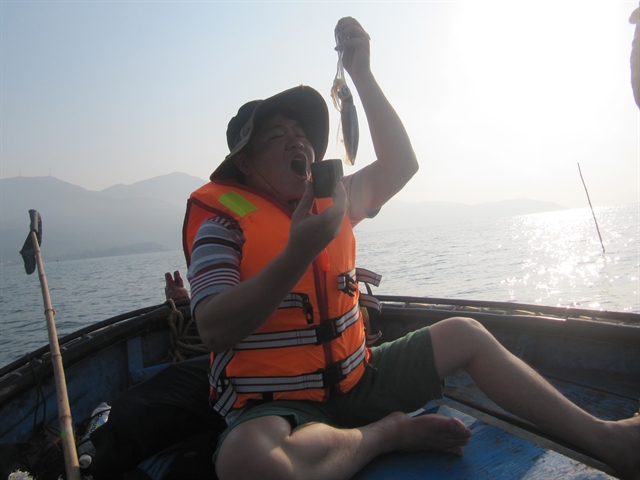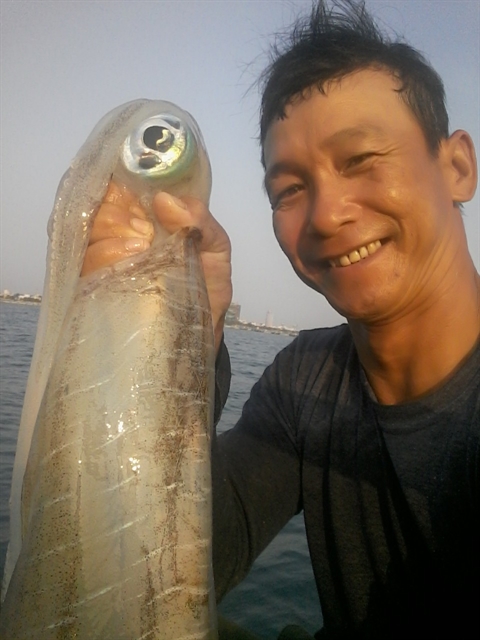 Life & Style
Life & Style

The men living in the crowded fishing community at the foot of the Sơn Trà Mountains often start their day with morning coffee and a chat about the work ahead.

|
| A sunset view on the beach of Sơn Trà in Đà Nẵng City. Beach, fishing lifestyle are favourite attraction to tourists in the coastal central city. VNS Photo Công Thành |
Công Thành
It’s about 4am and street vendor cafés are full of local fishermen before a new fishing day begins at dawn.
The men living in the crowded fishing community at the foot of the Sơn Trà Mountains often start their day with morning coffee and a chat about the work ahead.
Fisherman Đinh Dũng, 49, who has 25 years fishing experience, began his squid catching day at Rạn Rocks, off the coast of Thọ Quang Beach.

|
| A tourist enjoys catching a squid from snare during a day with fishing experience in water off Đà Nẵng beach. VNS Photo Công Thành |
His large coracle boat, equipped with a diesel-driven machine for quicker and farther trips, can carry a full batch of squid and lobster caught in net snares off the rocks.
We went fishing with Dũng on a hot summer day to explore the waters off Sơn Trà in Đà Nẵng City.
The bamboo-made coracle left the coast for the Rạn Rocks – about 10 minutes boat travel away for an area of abundant seafood.
Dũng said he anchored net snares (small square cages) that allow squid and lobsters to enter easily but stop them from getting out.
“It’s a one-way entrance trap that fishermen used to lure fish and squid swimming in for food in the cage, but they can't find the way out due to close net structure snares,” he explained.
“I left squid eggs or bait in snares to attract sea creatures. I keep the snares through the night and collect them the next morning. I had 20 snares in the waters off the rocks, and it took me two hours to collect squid and fish trapped in them.”
He said only bigfin reef squid or broad squid and lobsters swim into the snare to find food or to lay eggs.
Dũng guided us to lift snares that were anchored by bamboo poles deep in water and marked by foam floats.
Each snare, made of a bamboo frame and fishing, could hold two or three big squids at the same time.
“It’s up to tides and time. Squid find the food in the snares when it’s slow and quiet water. In high waves and strong flow, only a few squids are trapped,” he said.

|
| A squid is trapped in a fishing snare in the sea off Sơn Trà peninsula in Đà Nẵng. VNS Photo Công Thành |
He recalled that a 3.6kg squid was his biggest caught by snare and each kilo of alive squid helped him earn VNĐ400,000 (US$17) from wholesale on the beach.
Dũng said local traders often wait to collect fresh fish and seafood from fishermen and deals are made on the beach as soon as fishing trips ended.
He said he spent only two hours to check snares and then take the squid to be sold.
“I have other jobs to do, so I often finish my trips quicker than the other fishermen. There are different fishing jobs – from anchovy, net fishing, oysters, or tuna – among the fishing community.
“But some days I'm unlucky when all the squid do not come in. Bumper days compensate for no squid days.”
It was hard work lifting the snares and removing the squid.
Dũng warned us not to leave our fingers in the squid’s mouth as it could give us a nasty cut.
The squids stuck to our hands with their tentacles and we took time to get them off before putting them in a bucket of water.
All squid must be alive before going to a restaurant or market as raw squid (squid sashimi) was a popular order, Dũng said.

|
| Đinh Dũng, a local fisheman in Thọ Quang fishing community, enjoys catching a squid during his trip off the coast of Sơn Trà Peninsula. VNS Photo Đinh Dũng |
Dũng said he could offer a service of eating fresh squid on the coracle for a group of four or five travellers.
“I also host a sea trip for adventurers on the rocks. Visitors can explore how fishermen work at sea, while tasting seafood from fresh catches. Snorkels are used for coral reef watching during the trip.”
The water off the Sơn Trà Mountains is an ideal site to explore coral reefs and Dũng said he could take any tourists to swim around the rocks for only VNĐ100,000 ($4.3) per person from morning to afternoon.
He said that's the best time for snorkeling on coral reefs and tourists could order from travel agencies for luxury boats to fish offshore at night.
Dũng said visitors can fish in the coral reefs and could see fish eating bait through goggles.
"It was very interesting. It’s the first time I caught squid from snare. Dawn at sea is the most beautiful scenery that I enjoyed in the coracle trip,” said Trần Thanh Lâm, a local tourist.
“I could see black and red groupers swimming around coral reefs hunting bait from fishers.”

|
| Fishing boats and coracles dock at Thọ Quang fishing wharf in the Sơn Trà Peninsula of Đà Nẵng. Local fishermen still practice the trade on the beach of Đà Nẵng. VNS Photo Công Thành |
The trip often closes after one or two hours, and tourists return to the beach for seafood lunch.
"They are interesting activities. We often do every day, but tourists could take chances to understand our fishing lifestyle and sea life," Dũng said.
"We want to create an unforgettable experience for all tourists visiting Đà Nẵng and Sơn Trà Peninsula." — VNS




